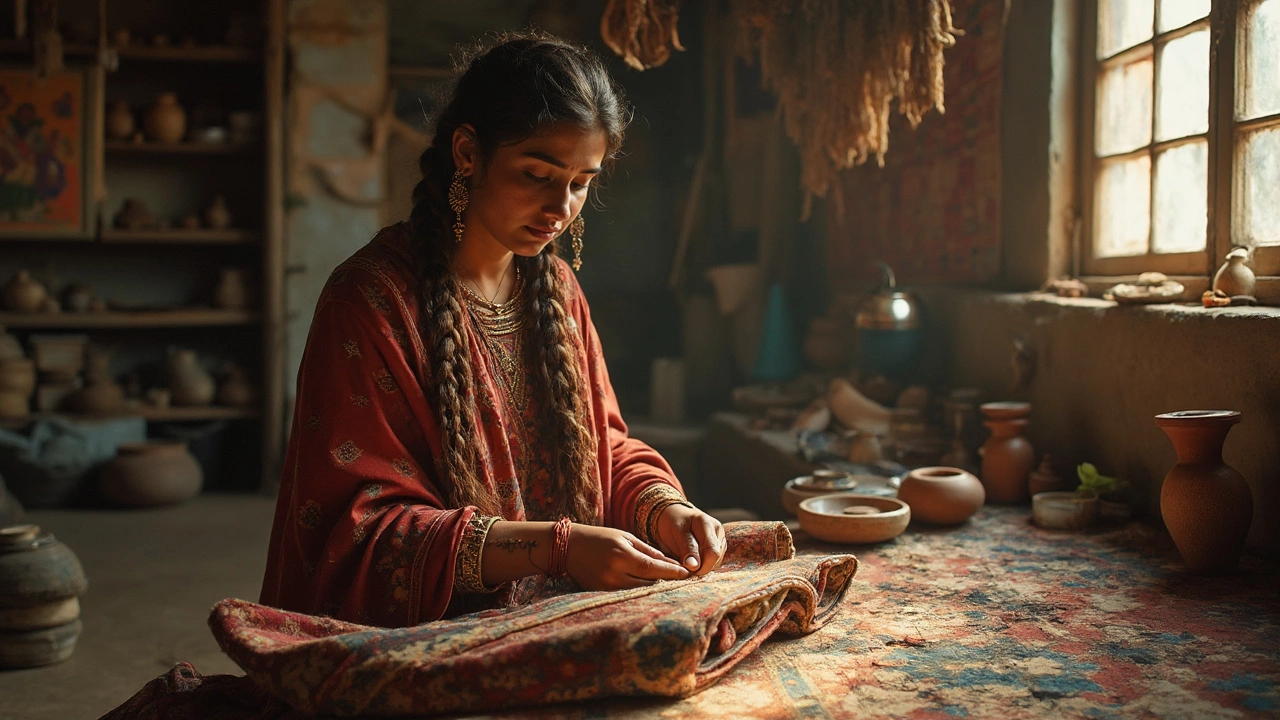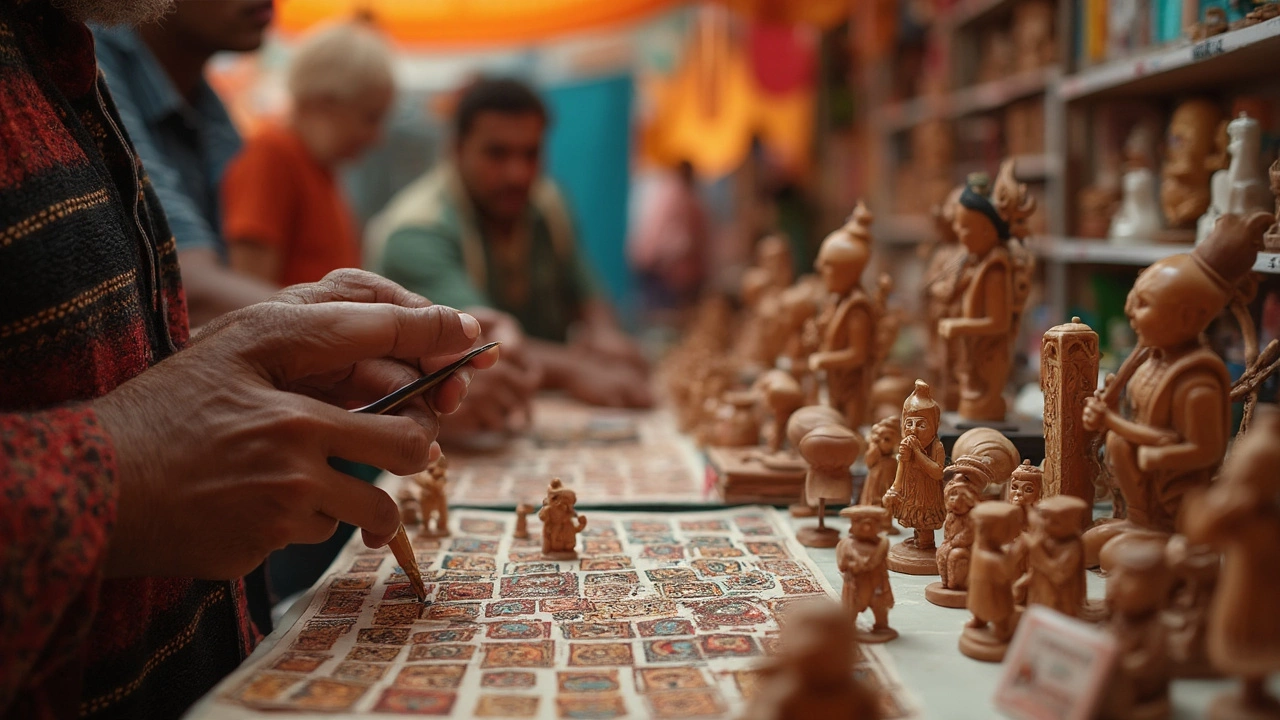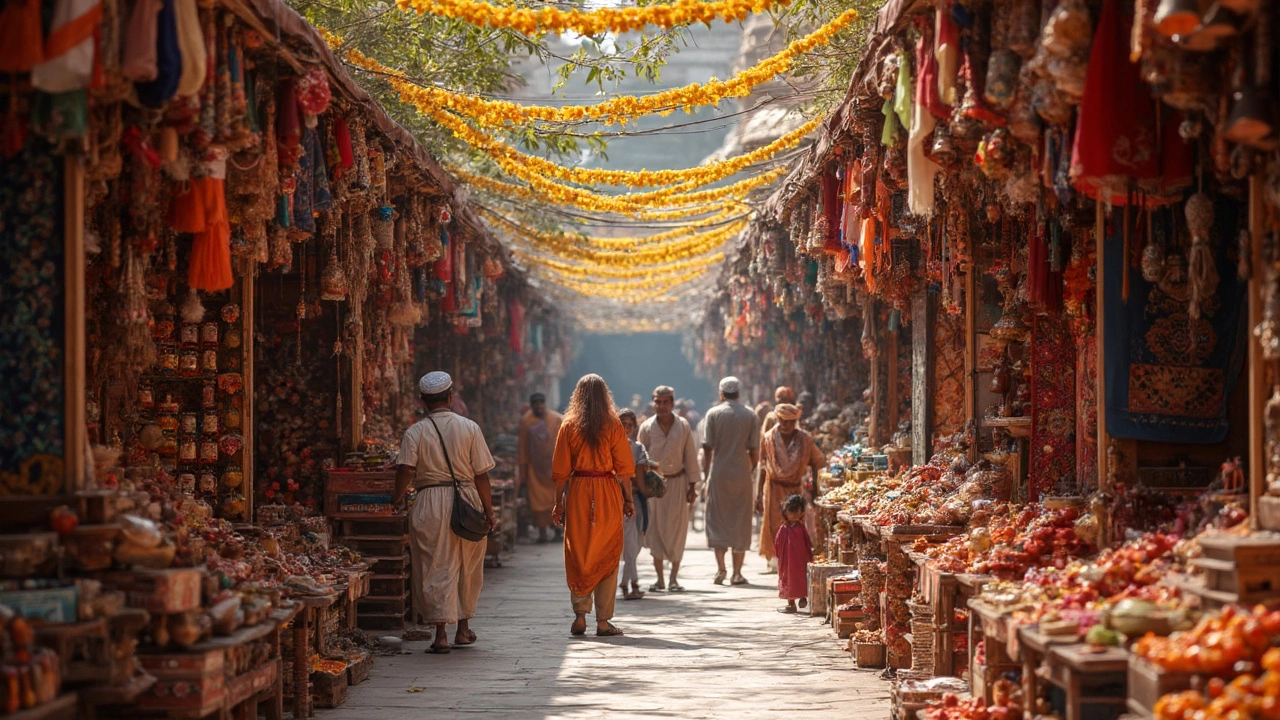Pretty much anywhere you go in India, something colorful catches your eye—be it a block-printed cushion cover, a metal lamp, or a woven basket. India doesn't just sell souvenirs. It churns out centuries-old art forms, shaped by local stories, climates, and communities. Each craft has roots deep in family traditions. We're talking about more than things to put on a shelf. We're talking about the habits, hopes, and skills people carry and pass on.
If you've ever seen a Kashmiri carpet or a bright Phulkari shawl and thought, 'How does anyone even make this?'... you're not alone. Indian handicrafts are all about detail. These aren't assembly-line products—there's usually a personal story behind every item. Names like Madhubani, Channapatna, and Kutch pop up in markets and craft fairs. If you've been tempted to pick something up, you're already part of this old-school chain of appreciation that stretches across time.
- What Makes Indian Handicrafts Unique
- Popular Regional Crafts and Where to Find Them
- Everyday Objects Turned Art
- How to Spot Authentic Handicrafts
- Supporting Artisans: Tips for Buyers
What Makes Indian Handicrafts Unique
Indian handicrafts stand out for one main reason: no two pieces are exactly the same. Each item—be it a clay pot or a handwoven rug—is made by real people, not just machines. The makers often learn their skills from family members, so these crafts carry years of tradition along with the final product.
Take block printing from Rajasthan. Each pattern is carved by hand onto wooden blocks. No printing press, just steady hands and sharp eyes. It’s slow work, but even a simple cotton scarf can show hours of handiwork. In Kashmir, carpet weaving takes it up a notch. One carpet might involve several weavers, each working for months or even years to finish a single rug.
Another big thing is the use of local materials. Pottery from Khurja uses local clay, while Kutch embroidery depends on wool and cotton grown nearby. The craft mixes with what’s locally available and what people actually use in daily life. This tight link to the region means you can often tell where an item comes from just by looking at its patterns, colors, or materials.
- Handmade = every piece has tiny flaws that make it special, unlike factory stuff.
- Storytelling: Many crafts, like Warli painting, actually show local legends and daily scenes.
- Eco-friendly: Items such as bamboo baskets from the Northeast or terracotta from West Bengal use natural resources and low-tech methods.
If you’re thinking about buying a souvenir or a gift, remember: an Indian handicraft is more than an object. It’s a slice of culture, history, and real skill passed from one generation to the next.
Popular Regional Crafts and Where to Find Them
When you hit up different corners of India, you quickly realize each region has its own style and specialty. It’s wild how much variety there is. Some crafts have even gotten ‘GI’ tags, meaning they’re recognized by law as unique to that area, just like Champagne has for France.
Here’s where you can spot—and buy—some of the best-known crafts:
- Indian handicrafts from Rajasthan: Think colorful block-printed fabrics in Jaipur, blue pottery, and those crazy-detailed Kathputli puppets. Shopper tip: Head straight to local bazaars like Johari or Bapu, but don’t forget the government emporiums for trusted quality.
- Uttar Pradesh: Famous for Chikankari embroidery from Lucknow, brassware from Moradabad, and the wooden toys of Varanasi. If you want authentic stuff, watch artisans work in the old neighborhoods—they're often happy to show you around.
- West Bengal: You’ll find Kantha-stitch quilts and sarees, and the iconic terracotta horses from Bankura. Try the Tant sari shops for handloom gems. Santiniketan and Kolkata’s New Market are hotspots.
- Karnataka: Hunt for Mysore silk sarees or Channapatna wooden toys—bright and safe for kids. If you're in Bangalore, try Cauvery Handicrafts Emporium for an easy one-stop shop.
- Kashmir: Walnut wood carving and Pashmina shawls top the list. Srinagar’s markets and nearby villages keep the craft alive, but watch for cheap knockoffs.
- Gujarat: Mirror work embroidery, Bandhani tie-dye, and the Kutch silver jewelry all shout ‘handmade.’ Try Bhuj's markets for the good stuff. Ask about the story behind the piece—you’ll learn a lot.
Curious about what’s trending or special by the numbers? Check out this quick table:
| Region | Famous Craft | Estimated Artisans (2024) | Main Market/City |
|---|---|---|---|
| Rajasthan | Block Printing | ~100,000 | Jaipur |
| Uttar Pradesh | Chikankari | ~250,000 | Lucknow |
| Kashmir | Pashmina Shawls | ~30,000 | Srinagar |
| Gujarat | Kutch Embroidery | ~50,000 | Bhuj |
| Karnataka | Channapatna Toys | ~10,000 | Channapatna |
A tip if you’re traveling: skip airport shops unless you’re in a pinch. For real variety and better prices, try regional crafts expos or state-run shops. And if a seller can share the process or name the artisan, that’s usually a good sign you’re getting the real deal.

Everyday Objects Turned Art
In India, everyday stuff like cups, plates, toys, and lamps often look like they walked straight out of an art museum. The reason? Generations of families turn basic items into something way more special—sometimes right in their backyard workshops. For example, the blue pottery of Jaipur can change a boring tea mug into a conversation starter. These things aren’t just pretty. They’re useful every day.
Wooden kitchen items, made in Saharanpur, UP, aren’t your basic spoons and boards. Each piece gets carved by hand, sometimes showing off floral or geometric designs. Ever heard of Bidriware from Karnataka? It’s an old metalworking technique where craftsmen inlay silver into blackened metal, usually turning out vases, cigarette boxes, or even door handles that really stand out.
Here are some well-known objects that have become symbols of Indian handicrafts:
- Channapatna Toys (Karnataka): These wooden toys, painted with natural colors, are made using a special lacquering process. Channapatna is nicknamed “Toy Town.”
- Bastar Ironware (Chhattisgarh): Tribal blacksmiths shape scrap iron into kitchen tools, diyas, and quirky animal figurines. Most of this happens in village forges where the same tricks have been used for centuries.
- Pattachitra Plates (Odisha): Artists use palm leaves or wooden plates and cover them with bright mythological scenes—a cool mix of storytelling and art.
- Kutch Embroidery (Gujarat): Decorated bags, cushion covers, and wall hangings get covered with mirrors, sequins, and colorful threads. Folks in Kutch use whatever they have—old cloth, scrap metal, even shells.
- Brass Lamps (Tamil Nadu): Most households keep one or more brass oil lamps—or diyas—both for lighting and for festivals. Many are still hand-cast using traditional sand molds.
Curious about how big this world is? Here’s a simple look at the states known for turning daily items into handiwork:
| State | Common Handicraft Objects |
|---|---|
| Rajasthan | Blue pottery, block-printed textiles, puppets |
| Karnataka | Lacquered toys, Bidriware, wooden combs |
| Uttar Pradesh | Wooden utensils, glassware, zari work |
| Odisha | Pattachitra plates, appliqué umbrellas |
| Gujarat | Kutch embroidery, beadwork, clay pots |
If you’re shopping, it helps to check the finish—smooth corners, strong colors, and real handwork details. Most genuine crafts don’t look exactly the same. That’s the beauty of buying something handmade: what you get is usually one of a kind.
How to Spot Authentic Handicrafts
Let’s be real—when markets are packed with lookalikes and mass-produced stuff, it can be tough to know what’s the real deal. Indian handicrafts have a certain charm and minor imperfections that come from human hands, not factory lines. Want to buy something original? Start with a close look: hand-painted pottery will rarely be exactly symmetrical, and a handwoven saree might have a loose thread or two. These details? That’s authenticity in action.
Ask about the backstory. Good sellers are proud of where their items come from. A Pashmina shawl vendor in Kashmir should know the history, the region, and the steps in making it—like how true Pashmina comes only from Changthangi goats. If everyone’s story sounds like a brochure, be wary.
Quality materials matter. Real Banarasi silk is soft yet crisp, never slippery and thin like polyester copies. Block-printed fabrics show ink bleed and minor variations, while machine-printed ‘crafts’ repeat the exact same pattern every time. For jewelry, authentic silver will be heavy, not lightweight like the plated stuff.
- Check for certifications or tags: India has Geographical Indication (GI) tags for crafts like Mysore silk or Kutch embroidery. These tags prove origins and traditional techniques.
- Look for artisan marks: Some items—like Dhokra art or Jaipur blue pottery—may have subtle marks or signatures, often hidden but there if you ask.
- Ask for a demo: In many craft fairs or villages, artisans will actually show you how it’s made. Watching someone carve, weave, or paint right in front of you is pretty good proof.
Avoid anything that’s a steal. If it’s way cheaper than expected, chances are it’s dodgy or synthetic. True crafts aren’t mass-produced bargains—they pay for skill, time, and tradition. When in doubt, ask questions, look closely, and trust your gut.

Supporting Artisans: Tips for Buyers
You might spot something cool at a local market or on an online shop, but there’s a big difference between grabbing a cheap copy from a middleman and actually supporting real Indian handicrafts made by local artisans. Want to make your purchase count? Here’s what you need to know.
First, check if the craft has any tag or certification. Products with a Geographical Indication (GI) tag are made in specific regions and follow time-tested methods. Think of products like Pashmina from Kashmir or blue pottery from Jaipur—these have legit roots.
Plenty of times, middlemen and bigger stores eat up profit margins, leaving artisans with only a small cut. Data from the Ministry of Textiles shows that middlemen can take up to 60% of the final price, while artisans get less than half the money paid by you.
| Channel | Approximate Share Received by Artisans (%) | Approximate Share Received by Middlemen/Retailers (%) |
|---|---|---|
| Direct (Fairs, Exhibitions) | 75-90 | 10-25 |
| Through Middlemen | 30-40 | 60-70 |
The easiest way to help? Buy directly from the makers. Look for government-run emporiums, self-help group stalls, and online sites like Dastkari Haat Samiti, Okhai, or The India Craft House. These platforms let you connect straight with craftspersons or their cooperative, so your money actually supports the maker.
Here are some simple things to remember when shopping for Indian handicrafts:
- Ask about the origin and maker. Real artisans are usually proud to talk about their process.
- Look for natural materials, hand-done stitches, or slight ‘imperfections’—signs something isn’t mass produced.
- If you’re overseas, check if the craft is certified export quality, to avoid nasty surprises at customs.
- Don’t be afraid to negotiate, but keep it fair—this isn’t a bargaining game like at a supermarket. Paying a little extra often means artisans can keep doing what they love.
- Share your find! Posting about your purchase on social media or telling friends can give artisans more reach than you think.
Bottom line: when buying a handmade item, a bit of research and awareness goes a long way. You get something unique, and someone in a small village or town gets to keep their craft—and community—alive.
